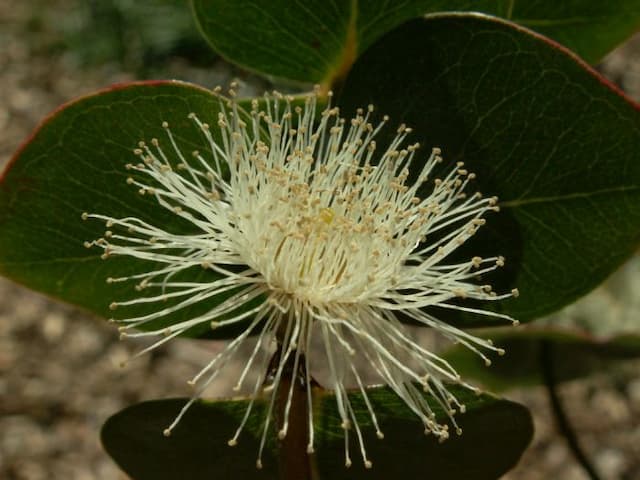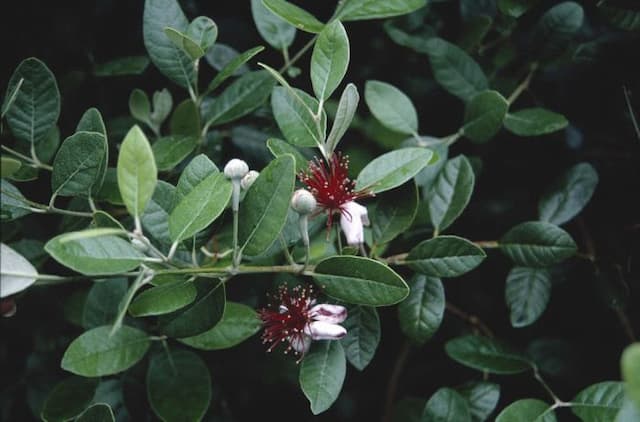Cider gum Eucalyptus gunnii Silverana = 'Lon40'

ABOUT
[Silverana] is an aromatic, evergreen tree with silvery-grey bark peeling to reveal cream or pinkish brown patches. Lance-shaped mature foliage is blue-green; rounded juvenile foliage is silvery-blue. Small, white, fragrant, fluffy flowers appear on mature plants in mid- to late summer, followed by woody, rounded, olive-green fruit
About this plant
 Names
NamesFamily
Myrtaceae.
Synonyms
Cider Gum, Silver Drop, Eucalyptus 'Silverana'.
Common names
Eucalyptus gunnii 'Silverana'.
 Characteristics
CharacteristicsLife cycle
Perennials
Foliage type
Evergreen
Color of leaves
Varies
Height
25 feet (7.62 meters)
Spread
15 feet (4.57 meters)
Plant type
Tree
Hardiness zones
7
Native area
Tasmania
Benefits
 General Benefits
General Benefits- Aesthetic Appeal: Eucalyptus gunnii Silverana offers ornamental value with its silver-blue foliage and peeling bark, enhancing visual interest in gardens and landscapes.
- Drought Tolerance: It is highly resilient to prolonged periods of dryness, requiring minimal watering once established, which makes it suitable for xeriscaping.
- Cold Tolerance: Unlike many other eucalyptus species, this variety can withstand cooler temperatures, making it a good choice for temperate climates.
- Fast Growth: It has a rapid growth rate, which ensures a relatively quick development of the landscape or garden space.
- Wildlife Attraction: The blooms can attract bees, butterflies, and birds, promoting biodiversity in the garden space.
- Low Maintenance: It requires little pruning or care once established, making it ideal for gardeners seeking low-maintenance plants.
- Scented Foliage: The leaves emit a pleasant scent when crushed, adding a sensory dimension to the garden experience.
- Windbreak: Its sturdy growth habit makes it useful as a windbreak or natural screen, offering protection and privacy to the garden.
 Medical Properties
Medical Properties- Antimicrobial: The essential oils from Eucalyptus gunnii are known to possess antimicrobial properties that can inhibit the growth of certain bacteria, fungi, and viruses.
- Decongestant: Eucalyptol, a compound found in the oils of Eucalyptus gunnii, is often used in cough lozenges and inhalants to help relieve congestion.
- Anti-inflammatory: Eucalyptus oil extracts may help reduce inflammation and alleviate pain in some conditions.
- Expectorant: Eucalyptus essential oils are commonly used as expectorants for relieving coughs and aiding in the clearance of mucus from the respiratory system.
 Air-purifying Qualities
Air-purifying QualitiesThis plant is not specifically known for air purifying qualities.
 Other Uses
Other Uses- Eucalyptus gunnii Silverana can be used as a natural dye source for fabrics, yielding colors from soft grays to vibrant oranges depending on the mordant used.
- The bark of this eucalyptus species can be processed into a waterproof material for small-scale crafts, such as decorative bowls or coasters.
- Fibers from Eucalyptus gunnii Silverana can be integrated into handmade papers, adding texture and strength to the paper.
- Leaves from the plant can be added to compost as a carbon-rich ingredient to balance nitrogen-rich materials and speed up the composting process.
- The essential oils extracted from the leaves can be used in perfumery for their refreshing and clean scent notes.
- When dried, the branches and leaves can serve as long-lasting elements in floral arrangements and wreaths.
- The plant can be trimmed into shapes and used as a living sculpture or topiary for garden art.
- The wood can be used in making small wooden trinkets or as handles for craft tools thanks to its hard, dense properties.
- The leaves may be used in culinary arts as a spice wrap, infusing slow-cooked meats with a unique flavor.
- The rapid growth of Eucalyptus gunnii Silverana can make it suitable for use as a windbreak or hedge in large landscape designs, providing both privacy and shelter.
Interesting Facts
 Feng Shui
Feng ShuiThe Cider Gum is not used in Feng Shui practice.
 Zodiac Sign Compitability
Zodiac Sign CompitabilityThe Cider Gum is not used in astrology practice.
 Plant Symbolism
Plant Symbolism- Healing: Eucalyptus is often associated with healing because of its medicinal properties, especially its ability to ease respiratory issues.
- Protection: Some cultures believe eucalyptus wards off evil spirits and provides protection, especially when planted around a home.
- Refreshing: The clean and invigorating scent of eucalyptus is thought to bring a sense of freshness and renewal.
- Purification: Its aromatic leaves are used in rituals and cleansing practices to purify a space or an individual's energy.
 Water
WaterCider Gum should be watered deeply once a week, allowing the soil to dry out slightly between waterings. In hot, dry conditions, it may require water twice a week. Ensure that the tree is getting approximately 2 to 3 gallons per watering session. It's crucial to adjust the frequency and amount of water based on rainfall, season, and soil conditions. Overwatering should be avoided to prevent root rot.
 Light
LightCider Gum thrives best in full sun, meaning at least six hours of direct sunlight each day. It should be positioned in a spot where it can receive unfiltered, direct sunlight for the majority of the day to ensure healthy growth.
 Temperature
TemperatureCider Gum performs well in a wide range of temperatures but prefers a range of 50°F to 90°F. It can tolerate occasional dips below freezing, down to about 20°F, but sustained cold below this threshold may damage the plant. Ideal conditions are in the warmer part of the range, without exposure to extreme heat or cold.
 Pruning
PruningPruning Cider Gum is helpful to maintain its shape and promote dense foliage growth. Prune during the late winter or early spring before the new growth starts. Remove any dead or damaged branches, and thin out the top of the tree to allow light and air to penetrate the canopy. Typically, pruning once a year is sufficient.
 Cleaning
CleaningAs needed
 Soil
SoilThe best soil mix for Cider Gum (Eucalyptus gunnii Silverana 'Lon40') should be well-draining with a mix of loam, sand, and organic matter. It prefers a pH range between 5.5 and 6.5, slightly acidic to neutral.
 Repotting
RepottingCider Gum saplings may need repotting annually, but mature trees have a slower growth rate and can be repotted every 2-3 years or when they outgrow their current pot.
 Humidity & Misting
Humidity & MistingCider Gum thrives in moderate to low humidity levels and is quite tolerant of dry air, making it well-suited for many interior environments.
 Suitable locations
Suitable locationsIndoor
Ensure bright light, proper drainage, slightly acidic soil.
Outdoor
Full sun, well-drained soil, protect from severe frosts.
Hardiness zone
7-10 USDA
 Life cycle
Life cycleEucalyptus gunnii 'Silverana', commonly known as Cider Gum, begins its cycle with seed germination, which requires stratification to break dormancy and a moist, well-drained growing medium. Once germinated, the seedling stage involves the development of primary roots and shoots, which will eventually develop into a young sapling. As the sapling grows, it enters the vegetative growth stage characterized by rapid stem elongation and the production of the species' distinctive round, silver-blue leaves. Following the juvenile phase, the plant matures and enters the reproductive stage, where it develops buds that bloom into small, white flowers, usually in the summer, and these are pollinated by insects or birds. After pollination, the flowers develop into woody fruit capsules, each containing numerous seeds, which when mature, are released to start a new generation. Throughout its life cycle, Cider Gum exhibits vigorous growth under suitable conditions, with the ability to tolerate cold climates and reach substantial heights if not pruned for ornamental or harvesting purposes.
 Propogation
PropogationPropogation time
Spring-Early Summer
For the Eucalyptus gunnii 'Silverana', also known as Cider Gum, propagation is most commonly achieved through the sowing of seeds. The ideal time for sowing Cider Gum seeds is late winter to early spring, when temperatures are cool but not freezing, which helps in the stratification process. To propagate by seed, fill a pot with a well-draining seed starting mix and sprinkle the tiny seeds on the surface, then lightly cover them with a thin layer of soil. The pot should be placed in a warm area with indirect light and kept moist until germination, which typically occurs within a few weeks. It's important to maintain a consistent temperature of about 65 to 75 degrees Fahrenheit (18 to 24 degrees Celsius) for optimal growth. Once the seedlings have grown enough to handle, they can be transplanted into individual pots or directly into the ground if the climate is suitable. This method is favored for its simplicity and effectiveness in producing true-to-type plants.




